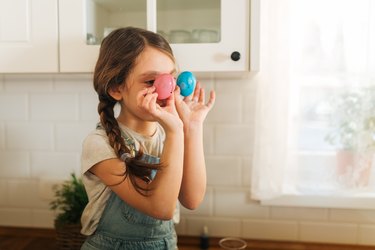
Dyeing eggs is a fun family-friendly tradition, whether you're decorating for spring or preparing for a visit from the Easter bunny,. Most egg dye kits call for the use of vinegar to help the dye stain the eggs, but the vinegar smell can be overpowering. Dye eggs without vinegar this year and follow this tutorial to learn how to dye eggs with food coloring.
Can You Dye Eggs Without Vinegar?
Vinegar is acidic. Adding acid to water creates the perfect conditions for dye to stick to an egg (or whatever you're dyeing). Eggshells are made up of calcium carbonate, which reacts with the acid in the vinegar to make carbon dioxide.
Vinegar encourages the dye to stick to the egg, which also deepens the colors of the dye. Dyeing eggs without vinegar will result in lovely light-colored eggs. If you prefer your eggs to be darker, you can darken them a bit by allowing the first dip to dry and then dipping the eggs back in the dye for a second bath. You can also substitute the vinegar for another acid, like lemon juice.
Video of the Day
Things You'll Need
Coffee mugs or bowls
Boiling water
Hard-boiled eggs (unpeeled)
Tongs or spoons
Paper towels
1. Pour Water Into Mugs
Pour boiling water to fill the mugs two-thirds of the way full.
Video of the Day
2. Add food coloring to each mug

Add about 20 drops of food coloring to each mug and stir it in. Continue adding more food coloring if you'd like the color to be stronger. Stick to one color per mug or mix different combinations of primary colors to make the perfect hue.
3. Gently place an egg in each mug
Gently place a hardboiled egg in each mug to dye eggs without vinegar. Allow the egg to sit in the dye for at least five minutes — leaving it in longer will deepen the color.
If your mugs or bowls aren't deep enough to completely submerge the eggs, use the tongs or a spoon to turn them every minute or two to cover the whole surface.
4. Lift the eggs from the dye
Lift the dyed eggs from the mugs of food coloring with tongs or a skimmer and set them on paper towels. Be sure to wipe the tongs before moving from one color to the next to avoid smudges and muddy colors.
5. Let the eggs dry and repeat as needed

Allow the eggs to dry on paper towels, rotating them every few minutes to make sure every side dries.
After this, you can either stop the egg dyeing process or place them back in the food coloring for another five minutes or so for a darker color. Repeat this process until you're satisfied with the hue of the egg.
Tip
Food coloring may stain plastic containers. Ceramic mugs allow you to submerge the egg completely without using large quantities of colored water without staining the material.